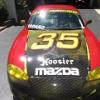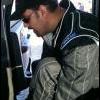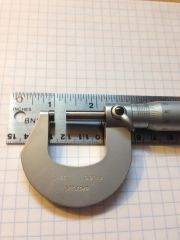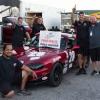Brandon,
"Similarly, if you feel some number does need to be specified to accommodate "standard machining procedures", be sure to spell that out in your letter as well.
I'm not an engine builder so I left that specific piece open to their knowledge and experience however I did attempt to clarify what I wished to see in the overall context of the rule: define, delimit, & delineate."
Based on your comment (above in quotes), here is a revision to the entire SCCA GCR's section "9.1.7.f. Cylinder Head" for Spec Miata. This was done with the intent of clearing up some ambiguities along with organizing the flow of the section to make it easier to follow (keep from jumping back and for when reading while trying to comprehend what was being communicated) as well as develop better wording relative to the Plunge Cut machining transition line which also makes a specific dimensional proposal considered to be reasonable and quantify'able ( and all above is open for debate).
f. Cylinder Head
1. The original casting must not be machined, welded, ported, polished or modified in any way except as authorized /specified below.
2. The gasket face of the cylinder head may be resurfaced provided the maximum compression ratio is not exceeded and the minimum height of the cylinder head is
maintained. The minimum allowed heights of the cylinder heads as measured in the factory service manual are shown in the following table.
(Use Existing GCR Table w/o change)
3. The “throat area†of the port is defined here as being the inside diameter beginning in the lower portion of the cast steel valve seat that is at a 90 degree angle to the flat plane of the valve seat and which also extends/transitions down into the aluminum casting below the seat.
4. It is permitted to plunge cut the “throat area†in order to correct core shift that is commonly found in many cylinder heads. This cut must be concentric with the valve guide axial centerline and cannot extend further than the specified number (shown below) as measured from the bottom of the ferrous valve seat. There can be no tooling or machine marks in the head below this specified number. The “throat area†as defined in “3.†above will be measured with a gauge and must conform to the maximum diameters and depths listed in the table below.
(Use Existing GCR Table w/o change)
5. No aluminum in the bowl area and/or port (other than that specified for the plunge cut) may be removed, added or manipulated for any reason other than as described here. It is understood that the head may look slightly different from bowl to bowl due to casting irregularities. The area under the valve seat where the plunge cut ends and the casting resumes cannot be blended by hand, machined or chemically/electrically processed to create a smooth transition. No material may be removed or added from the short term radius in the port. The plunge cut to valve bowl, port walls “transition machining line†may be hand processed only for the purpose of removing “machining flashâ€. This is to be done using a flexible abrasive medium such as a Scotch-Bright pad, steel wool or paper/cloth. There can be no tooling or machine marks created along the “transition machining line†with this" permitted" process as could result from the use of a hand scraper/file tool or a rotating power tool. Additionally the flash removal process cannot result in a width (where the machine/casting transition line is smoothed of any visible surface irregularities) greater than 1 mm. This “transition machining line†hand processing criteria may also be applied to the head combustion chamber after resurfacing per†2.†above.
6. It is permissible to remove and replace the valve seat inserts for the purpose of repairing a head within OEM valve location tolerances using aftermarket replacement seats meeting OEM dimensions.
7. Spark Plug threads may be repaired with the use of the various aftermarket available thread inserts as long as the spark plug installed depth position is not altered from OEM.
8. Valve guides may be replaced provided the position of the valve is not changed and the replacement guides are Mazda OEM parts. (Wording to be extracted from current section†h. Valves, paragraph 1.†Shown Highlighted in the full paragraph below for reference.)
h. Valves
1. OEM valves must be as supplied by Mazda. Valve location
or angle must not be moved. Reshaping of the valves is
strictly prohibited. Valve guides may be replaced provided
the position of the valve is not changed and the replacement
guides are Mazda OEM parts. Valve stem installed
height must be per the Mazda factory service manual:
Rich Powers




 Sign In
Sign In Create Account
Create Account








 Back to top
Back to top Report
Report























